Our planet, Earth, hosts more than 30 million animal species. However, a number of those species are at a risk of extinction due to man’s intervention for consumption or entertainment. Endangered species are found throughout the world. Endangered means that the animal is nearly extinct. Many different reasons are in place for the extinction of these animals, whether it is to use for their fur, the oil they produce or as a food source. There are several different types of endangered species. Here we will take a look some of the most endangered species out there.
See Also:
1. Hawksbill Sea Turtle

The Hawksbill Turtle is a sea turtle that has decreased in number due poaching for its beautiful shell. Now both import and export of the Hawksbill Turtle are prohibited. But there is another problem: the sandy beaches where it lays its eggs are disappearing. Hard times will continue for the Hawksbill Turtle.
Hawksbill Turtles are known for their sharp, pointed beak. Try comparing the Hawksbill Turtle to other sea turtles and you’ll see. Meanwhile, Hawksbill Turtles eat sea sponges stuck to dead corals. Their Shell Size normally around 70-90cm and Weight about 30-70kg.
Read: Endangered Dolphin Species – Sea Turtle Facts
2. Steller Sea Lion
 Steller sea lions are the largest of the otariids and the fourth largest of the pinnipeds, meaning “feather” or “fin” footed. Steller sea lions have large, bulging eyes, and flat, square noses. Steller sea lions also have long whiskers which are used to navigate underwater and find prey.
Steller sea lions are the largest of the otariids and the fourth largest of the pinnipeds, meaning “feather” or “fin” footed. Steller sea lions have large, bulging eyes, and flat, square noses. Steller sea lions also have long whiskers which are used to navigate underwater and find prey.
The ears of a Steller sea lion are visible and are turned downwards so that water does not enter them when the sea lions go underwater. When adult males age, they develop a “mane” of long, coarse hair. Steller sea lions are particularly agile on land and swim using
The ears of a Steller sea lion are visible and are turned downwards so that water does not enter them when the sea lions go underwater. When adult males age, they develop a “mane” of long, coarse hair. Steller sea lions are particularly agile on land and swim using
Steller sea lions are particularly agile on land and swim using theirfore-flipperss. Adult males grow 2-3 times as large as an adult female. Adult males have thickened necks and triangular shaped heads. Both male and female sea lions have large front and rear flippers.
Read: Endangered Sea Lions – Fishes in Atlantic Ocean
3. Blue Whale
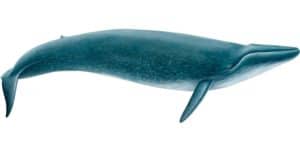 Blue Whale is the most massive animal ever to have lived, a species of baleen whale that weighs approximately 150 tons and may attain a length of more than 30 meters (98 feet). The largest accurately measured blue whale was a 29.5-meter female that weighed 180 metric tons (nearly 200 short [U.S.] tons).
Blue Whale is the most massive animal ever to have lived, a species of baleen whale that weighs approximately 150 tons and may attain a length of more than 30 meters (98 feet). The largest accurately measured blue whale was a 29.5-meter female that weighed 180 metric tons (nearly 200 short [U.S.] tons).
However, there are reports of 33-meter catches that may have reached 200 metric tons. The heart of one blue whale was recorded at nearly 700 kg (about 1,500 pounds). This largest animal on Earth feeds almost exclusively on one of the smallest, krill, shrimp-like crustaceans. Such gargantuan harvests depend on the continuing fertility of the oceans. More than 300.000 Blue Whales roamed around the oceans. Now, less than 3% that remained.
Read Also: Conservation of Blue Whales – Facts of Blue Whales
4. Florida Manatee
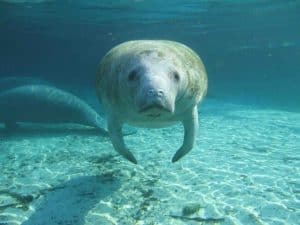 The manatee is a large marine mammal with an egg-shaped head, flippers and a flat tail. Manatees range in size from 8 to 13 feet (2.4 to 4 meters) and can weigh 440 to 1,300 lbs. (200 to 590 kilograms). They have large, strong tails that power their swimming. Manatees usually swim about 5 mph (8 km/h), but they can swim up to 15 mph (24 km/h) in short bursts when they feel a need for speed, according to National Geographic.
The manatee is a large marine mammal with an egg-shaped head, flippers and a flat tail. Manatees range in size from 8 to 13 feet (2.4 to 4 meters) and can weigh 440 to 1,300 lbs. (200 to 590 kilograms). They have large, strong tails that power their swimming. Manatees usually swim about 5 mph (8 km/h), but they can swim up to 15 mph (24 km/h) in short bursts when they feel a need for speed, according to National Geographic.
Manatees are herbivores. At sea, they tend to prefer sea grasses. When they live in rivers, they consume freshwater vegetation. Manatees also eat algae. According to National Geographic, a manatee can eat a tenth of its own weight in 24 hours. That can equal up to 59 Kg.
Read: Endangered Species in Pacific Ocean – Ocean Seashells
5. Vaquita Dolphin
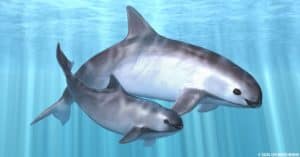 The Vaquita Dolphin discovered in 1958. Since then is lommers have only been decreasing. Vaquita dolphin corpus is only found in one place. On earth north of the California Gulf. It’s found in fairly shallow waters up dirt through the ninety-two feet.
The Vaquita Dolphin discovered in 1958. Since then is lommers have only been decreasing. Vaquita dolphin corpus is only found in one place. On earth north of the California Gulf. It’s found in fairly shallow waters up dirt through the ninety-two feet.
In each other vaquita is to have a role in the food chain by eating squid, golf croaker, Braun’s choked, grunts and other fish. Then. to be eaten by animals like sharks and killer whales. The threats that endanger the vaquita can be very severe.
In fact, there is estimated to be only 60 Vaquita’s left. Some research said by 2018 all the Vaquita will be extinct. some things that threaten them include global warming, getting caught and guilt in fish and getting killed by shrimp boats.
Read:
6. Hawaiian Monk Seal
Seals and Sea Lions are among the ocean’s  most endearing creatures. Most seals and sea lions live in the cool water of temperate seas, or the frigid water of polar regions. The so-called Monk seals are the only seals that live in the tropics.
most endearing creatures. Most seals and sea lions live in the cool water of temperate seas, or the frigid water of polar regions. The so-called Monk seals are the only seals that live in the tropics.
The Hawaiian Monk Seal is critically endangered. There are less than 1,200 animals left. Human encroachment is one of the main threats facing the recovery of the Hawaiian Monk seal population. And Tiger sharks are a big threat to the pups that are just learning to swim.
Read: Endangered Sea Lions – Way to Save The Dolphins
7. Kemp’s Ridley Turtles
 Migrating between the Atlantic Ocean and the Gulf of Mexico, the Kemp’s Ridley sea turtle is the rarest sea turtle and is endangered to a severe degree. Only 500 of this marine species are believed to be surviving the habitat loss, marine pollution, and entanglement in fishing nets.
Migrating between the Atlantic Ocean and the Gulf of Mexico, the Kemp’s Ridley sea turtle is the rarest sea turtle and is endangered to a severe degree. Only 500 of this marine species are believed to be surviving the habitat loss, marine pollution, and entanglement in fishing nets.
Harvesting of eggs have been made illegal and research projects of incubating and hatching the eggs in temperature-controlled rooms have been undertaken to save this endangered marine species.
Read: Animals in The Ocean Biome – Red Sea Fish Species
8. Humpback Whale

Not a toothed whale, they are equipped with baleen, a very unusual feature that resembles thick strands of long hair that hangs down from their upper jaw and acts like a strainer enabling the whale to grab all the plankton, krill and small fish that is filtered through these strands. They eat about a ton of food each and every day during the feeding season.
In addition, they migrate south to warmer waters in the winter (Baja and Hawaii) where they do not eat at all but survive off their blubber. Instead, they focus all their attention on mating and giving birth.
On the other hand, females reach sexual maturity at 4-6 years, males take a little longer. A typical gestation period is 11 – 12 months. Calves will stay close to their mother for one year, making the trip north and back again only once before they become independent. They typically live up to 50 years.
Read : Facts of Whale Shark – Endangered Sea Turtles List
9. Crinoid Shrimp
 Can likely tell by its name, this creature belongs to the species up Snapping shrimp. But, it’s the only one that is endangered. They also are known as pistol shrimp because they made a loud cracking shooting voice. It actually shoots there but the pistol is strong enough to sting the prey that happens to swim past.
Can likely tell by its name, this creature belongs to the species up Snapping shrimp. But, it’s the only one that is endangered. They also are known as pistol shrimp because they made a loud cracking shooting voice. It actually shoots there but the pistol is strong enough to sting the prey that happens to swim past.
These shrimp measure about 1 centimeter and live off of the mucus of sea creatures called feather stars also known as crinoids. Crinoids play host to any number of commensal relationships with a variety of different marine life.
Crinoids can have anywhere from a dozen to hundreds of branching arms that are highly flexible and play an important part in gathering food and offering protection to the fragile organs found on the central disc. It’s within these sticky and retractable arms where the majority of crinoid commensals seek shelter.
See: Endangered Sea Cucumbers– Producers in Ocean Ecosystems
10. Sockeye Salmon
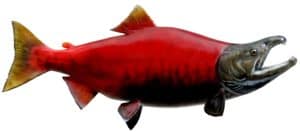 It’s the common species of salmon in the Pacific ocean and migrates from sea to fresh water to spawn. Their breeding process can be difficult because they lay eggs in the river and then return to the sea. Both the river and the sea are necessary to culture salmon.
It’s the common species of salmon in the Pacific ocean and migrates from sea to fresh water to spawn. Their breeding process can be difficult because they lay eggs in the river and then return to the sea. Both the river and the sea are necessary to culture salmon.
These fish are prized for their raw meat which is served as Sashimi. Once they got caught their life cycle is shortened and the species have no chance if the species have no chance to laid millions of eggs. They are listed in the U. S. Endangered Species Act.
See: Endangered Fishes Species – Biggest Fish in Amazon
11. Napoleon Wrasse

This huge colorful fish commonly found in the western Pacific ocean and in the Indian ocean. Unfortunately, it’s amazing coloration makes it desirable as a luxury in Asia. And once eaten by royalty major.
Talk about the huge of this fish. It can grow to a length of 7 feet and weigh as much as 420 pounds. However, most males grow to an average length of 6 feet with females being much smaller at a length of 3 feet. Despite its enormous size, it is easily scared off.
Consumers of the fish today include China, Singapore, and Malaysia and also imported illegally in the Philippines. Other factors to its declining numbers include habitat loss and illegal fishing activities.
12. Scalloped Hammerhead Sharks
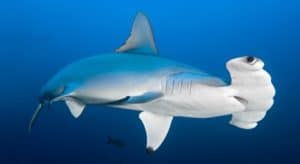 You can likely identify this creature by its unique shape of its head and they use that noggin as a weapon when they’re hunting. They live in warm and tropical coastal waters around the world. These creature has been listed as globally endangered.
You can likely identify this creature by its unique shape of its head and they use that noggin as a weapon when they’re hunting. They live in warm and tropical coastal waters around the world. These creature has been listed as globally endangered.
In the Atlantic ocean, the population has declined by more than 95% over the past three decades. Overfishing and the demand of the shark fins are among the reasons for those shrinking numbers.
Hammerhead sharks are the most sharks commonly caught for thinning. That’s the practice of shearing off the animals’ fins then throwing the back the animal’s body to the water.
See also: Conservation of Oceans – Endangered Species of Whale
13. Fin Whale
T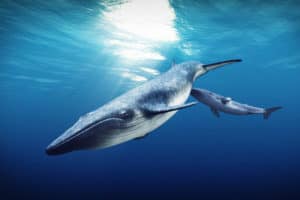 his is the second largest animal after the blue whale and is found from polar to tropical waters. As with other large whales, this animal was hunted heavily throughout the 20th century and is considered an endangered species.
his is the second largest animal after the blue whale and is found from polar to tropical waters. As with other large whales, this animal was hunted heavily throughout the 20th century and is considered an endangered species.
Even though the International Whaling Commission issued a moratorium on the commercial hunting of this whale, Japan and Iceland have resumed hunting. Global estimates for the population range from under 100,000 to around 119,000. Asian stocks of the Fin Whale are considered critically endangered.
14. Green Sea Turtles
 There’s a global trade in turtle meat and turtle products and that serves endangered this creature. Some of the animals are caught and killed in the young ages and dried and varnished to be sold as curio items.
There’s a global trade in turtle meat and turtle products and that serves endangered this creature. Some of the animals are caught and killed in the young ages and dried and varnished to be sold as curio items.
The animals also poached for the shells which can fetch steep prices. The reason why the sea turtles are named as such is that they eat green sea grass and seaweed. They also have a layer of green layer fats under the shells.
See also: Conservation of Tortoise – Ways to Protect the Marine Life
15. Borneo Sharks
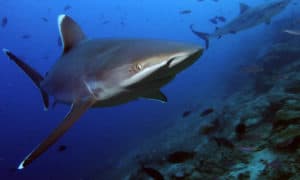 Borneo sharks are mercilessly hunted for the meat and for the fins which is considered as a delicacy. Borneo sharks have been listed endangered International Union for Conservation of Nature (IUCN). These are often considered the rarest of all sharks and only inhabit misty rivers.
Borneo sharks are mercilessly hunted for the meat and for the fins which is considered as a delicacy. Borneo sharks have been listed endangered International Union for Conservation of Nature (IUCN). These are often considered the rarest of all sharks and only inhabit misty rivers.
Borneo shark is slate gray above, darkening toward the tips of dorsal fins and upper lobe of the caudal fin, and white below. There are faint, light edges on the pectoral, pelvic and anal. The maximum size known is 70 cm (28 inches). The only confirmed specimens were found in 1937 and 2004.
See also: Ocean Animals – Types of Sea Urchins
Finally, those are complete explanation and further information about Endangered Animals in The Ocean world. After knowing these, hopefully that you can more respect about the existence of ocean ecosystems.